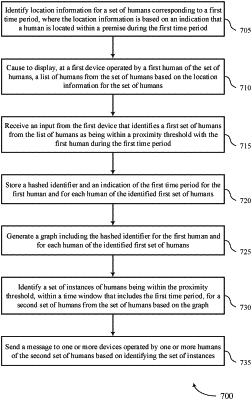| CPC G06Q 30/01 (2013.01) [G06T 11/206 (2013.01); H04W 4/021 (2013.01); G06F 3/0482 (2013.01)] | 20 Claims |

|
1. A method for physical proximity graphing, comprising:
identifying location information for a first plurality of humans corresponding to a first time period, wherein the location information is based at least in part on an indication that a human is located within a premise during the first time period;
causing to display, at a first device operated by a first human of the first plurality of humans, a list of humans from the first plurality of humans based at least in part on the location information for the first plurality of humans;
receiving, from the first device, a user input to the first device that selects a second plurality of humans, from the list of humans, who were within a proximity threshold with the first human during the first time period;
storing a hashed identifier and an indication of the first time period for the first human and for each human of the selected second plurality of humans;
generating a graph comprising the hashed identifier for the first human and for each human of the selected second plurality of humans based at least in part on the user input;
identifying a set of instances of humans being within the proximity threshold, within a time window that includes the first time period, for a set of humans from the first plurality of humans based at least in part on the graph; and
sending a message to one or more devices operated by one or more humans of the set of humans based at least in part on identifying the set of instances.
|